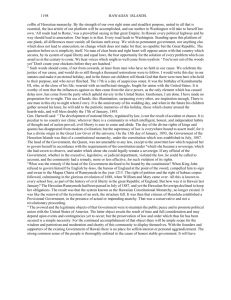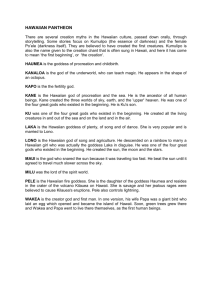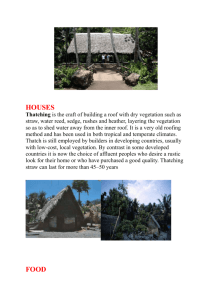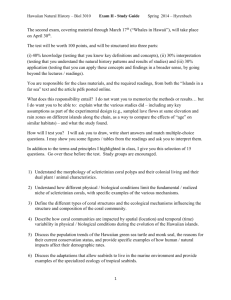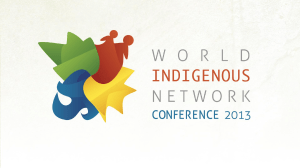6/24/13 Descriptions of Locations on Hoa 'Aina O Makaha Farm Map
advertisement
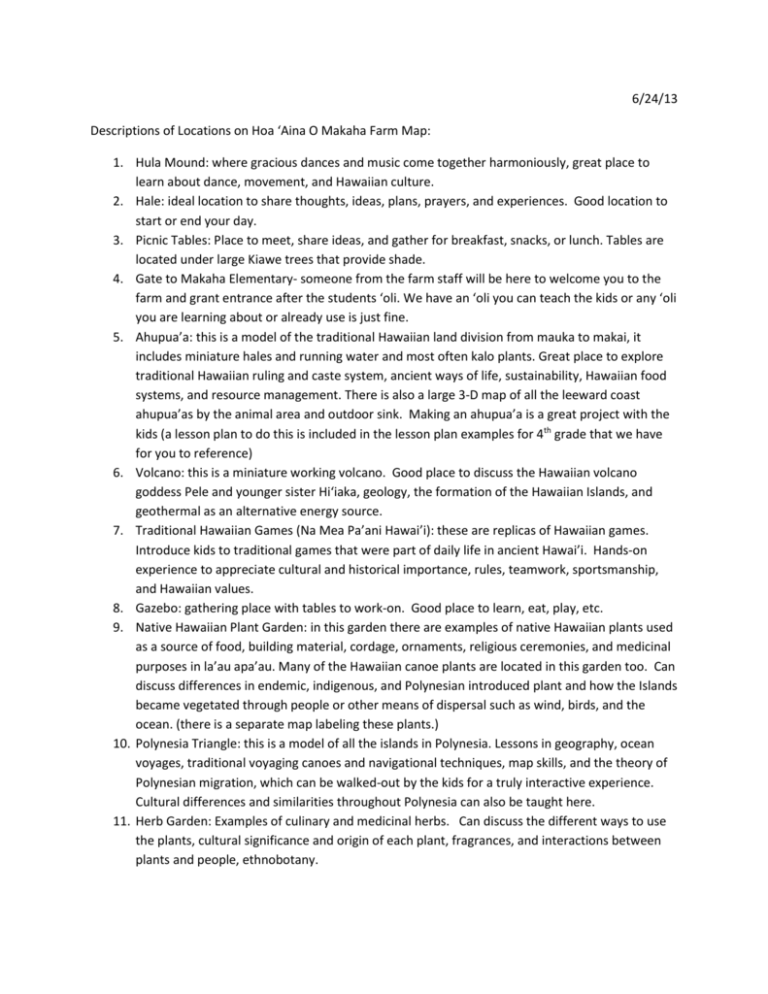
6/24/13 Descriptions of Locations on Hoa ‘Aina O Makaha Farm Map: 1. Hula Mound: where gracious dances and music come together harmoniously, great place to learn about dance, movement, and Hawaiian culture. 2. Hale: ideal location to share thoughts, ideas, plans, prayers, and experiences. Good location to start or end your day. 3. Picnic Tables: Place to meet, share ideas, and gather for breakfast, snacks, or lunch. Tables are located under large Kiawe trees that provide shade. 4. Gate to Makaha Elementary- someone from the farm staff will be here to welcome you to the farm and grant entrance after the students ‘oli. We have an ‘oli you can teach the kids or any ‘oli you are learning about or already use is just fine. 5. Ahupua’a: this is a model of the traditional Hawaiian land division from mauka to makai, it includes miniature hales and running water and most often kalo plants. Great place to explore traditional Hawaiian ruling and caste system, ancient ways of life, sustainability, Hawaiian food systems, and resource management. There is also a large 3-D map of all the leeward coast ahupua’as by the animal area and outdoor sink. Making an ahupua’a is a great project with the kids (a lesson plan to do this is included in the lesson plan examples for 4th grade that we have for you to reference) 6. Volcano: this is a miniature working volcano. Good place to discuss the Hawaiian volcano goddess Pele and younger sister Hi‘iaka, geology, the formation of the Hawaiian Islands, and geothermal as an alternative energy source. 7. Traditional Hawaiian Games (Na Mea Pa’ani Hawai’i): these are replicas of Hawaiian games. Introduce kids to traditional games that were part of daily life in ancient Hawai’i. Hands-on experience to appreciate cultural and historical importance, rules, teamwork, sportsmanship, and Hawaiian values. 8. Gazebo: gathering place with tables to work-on. Good place to learn, eat, play, etc. 9. Native Hawaiian Plant Garden: in this garden there are examples of native Hawaiian plants used as a source of food, building material, cordage, ornaments, religious ceremonies, and medicinal purposes in la’au apa’au. Many of the Hawaiian canoe plants are located in this garden too. Can discuss differences in endemic, indigenous, and Polynesian introduced plant and how the Islands became vegetated through people or other means of dispersal such as wind, birds, and the ocean. (there is a separate map labeling these plants.) 10. Polynesia Triangle: this is a model of all the islands in Polynesia. Lessons in geography, ocean voyages, traditional voyaging canoes and navigational techniques, map skills, and the theory of Polynesian migration, which can be walked-out by the kids for a truly interactive experience. Cultural differences and similarities throughout Polynesia can also be taught here. 11. Herb Garden: Examples of culinary and medicinal herbs. Can discuss the different ways to use the plants, cultural significance and origin of each plant, fragrances, and interactions between plants and people, ethnobotany. 12. Carpentry Shop: Tools and machines can be used to create new things and make ideas come to life. Great place to introduce students to simple machines such as the pulley or lever. (Let us know if you have projects in mind) 13. Outdoor Area/Sink: Covered outdoor area for separating, collecting, and washing food that was harvested from the farm. 14. Lipstick Tree: Also known as the annatto, achiote, alaea laau, and kumauna tree (last two are the Hawaiian names). The scarlet seeds from this small shrub or tree are used in many different cultures for culinary purposes as well as a material for dyeing. Ancient Hawaiians used the seeds for dyeing the traditional clothing kapa, bark cloth made from wauke, the paper mulberry tree (a young tree is planted in the Native Hawaiian Plant Garden). Seeds can be harvested to demonstrate dyeing capabilities and lessons in ancient Hawaiian uses of the plant as well as the plants significance in other Polynesian cultures such as Tongan’s dying their bark cloth, tapa. 15. Noni Tree: this tree is located not just here but in other areas on the farm. These trees usually always have bees buzzing in them so it’s a good place to observe the interaction of plants and their pollinators. This can expand into lessons about food webs and food chains, the evolution of plants and animals according to their interactions, the more “unseen” world of plant development, plant reproductive system, pollination, and can be a good place to carry out the lesson on sounds of the farm (in the “Na Keiki O Ka Aina” lesson plan ideas, lesson 1 “Sounds of a Farm”). Lessons on ancient Hawaiian healing plants, noni was used medicinally as a tea, oil, poultices, enemas, liniments, syrups, and tinctures, the seeds were brought over as a canoe plant, and since its used in many other cultures for similar medicinal purposes it can highlight cultural similarities and the passing on of knowledge from generations as people migrated throughout Polynesia. 16. Imu: this traditional underground oven was used for cooking and steaming native food plants such as breadfruit, bananas, sweet potatoes, taro, and chicken, fish, and pig. Not only were native foods being cooked in the imu but native plants like banana stumps, ti leaves, banana leaves, and honohono grass were used to fuel the imu. This is an activity that we can set – up for demonstrations, but we need plenty of notice. 17. Citrus Grove: many different types of citrus trees are grown in this grove such as tangerines and pomelos but there are also soursop and ulu trees. Expansion on the differences and similarities of citrus plants can be made as well as plant families, the characteristics needed to classify citrus fruits, dichotomous keys, and using the “Ke Ala” suggested lesson plans for showing kids that plants reproduce offspring that are genetically similar to themselves. 18. Kalo Fountain: benches are provided encircling a large kalo leaf shaped fountain, representing the ancient Hawaiian ancestor Haloa, making it a perfect place to gather and talk story about the day’s lesson and reinforce what the students have learned. Reading and writing activities based on the lesson taught at the farm can be carried out here to help with writing and literacy skills in a more place-based learning style. 19. Hawaiian Gods: 4 rocks representing the 4 Hawaiian gods, Ku, Kane, Kanaloa, and Lono are located among a serene path in the Wao Na Lani forest. Kane will be the first you encounter on the left, then Lono on the right, Kanaloa will be right where the road starts to curve and has a 20. 21. 22. 23. 24. 25. 26. piece of coral on top, and Ku will be the last on the left. History in ancient Hawaiian chants and rituals, representations of each God, and the Gods significance in Hawaiian culture. Peace Garden: This garden combines footsteps and flowers in harmony to send a message to the world. Good place to visit if students are learning about peace in general and peace movements in history such as Dr. Martin Lurther King’s and Ghandi’s activism. K-6 and Ke Ala Gardens: This area is dedicated to the K-6 grade levels for Makaha Elementary School and our visiting schools in the Ke Ala program to plant in. There are endless possibilities for lessons here. Kids learn how to take care of the land and how the land in turn takes care of them, the similarities between plants and people, parts of plants, photosynthesis, and how to plant, care for, and harvest their own garden. We can set up all the necessary supplies such as seeds, seedlings, soil, and compost to help establish your garden and assist with a gardening lesson plan. Kalo- Dryland kalo, or known as taro in other parts of Polynesia, varieties are grown here without the use of flooding as in a lo’i. Kalo is probably the most important plant in the Hawaiian culture so many lesson plans can be derived from this area such as the Hawaiian creation story, the story of Haloa, the uses of every plant part, the names of the different parts and their connection with the Hawaiian words for family, the evolution of the Hawaiian alphabet and the similarities and differences between Hawaiian words and those throughout Polynesia, preparing huli and planting, and of course cooking and eating. We can arrange to help the students make poi and laulau. Nipa Hut: this is a miniature version of the traditional and indigenous hut lived in by the people of the Philippines. Represents a sustainable and traditionally built structure constructed out of green materials found in the Philippines such as bamboo, coconut, and grasses. The hut is designed to be raised on stilts where people live in the upper hut and the bottom area is used to house smaller livestock such as chickens and goats. This design exemplifies how different cultures interact with livestock and their surrounding while living in harmony with nature and off the land. Nursery: this shade-house style nursery is where we start our seedlings that will later be transplanted into the various gardens and fields. The nursery provides a good place to show the beginning of a plant’s life cycle from seed to adult, how plants develop, germination, planting techniques, and different growing techniques such as seeds, seedlings, or cuttings. Comparisons of plants to people can be illustrated here, one of the main philosophies at Hoa ‘Aina O Makaha, seedlings are like kids and need to be nurtured to grow and need to be treated nicely and gently because they are small and delicate. Container Gardens: this area is dedicated to teaching kids and families in the community that even with limited space it is possible to become self-sufficient and start growing their own food in simple containers or raised beds to promote healthy eating and healthy families. These gardens help address and reduce diet-related health concerns such as childhood and adult diabetes. These garden designs can easily be implemented in schools that don’t currently have a school garden for continued land stewardship and other lessons closer to the classroom. Bathrooms: two single stall bathrooms. 27. Kitchen: This full kitchen is equipped with two ranges, an oven, sink, fridge and freezer, and large tables for the kids to sit and view cooking demonstrations and to use when participating. The kitchen is a great resource to promote healthy eating by preparing the food, the kids spent so much energy growing, immediately after harvesting, ensuring that they are getting all of the beneficial nutrients from foods that are as fresh and local. We have many healthy and easy recipes that we are happy to share with you. 28. Office: the office of Hoa ‘Aina is located here for any administrative purposes. 29. Pizza Oven: this traditional, homemade pizza oven allows the kids to prepare a delicious pizza from produce they harvested from their garden and any herbs that are needed can be found in the adjacent pizza herb garden. We will assist with this lesson since the oven is fueled by fire inside the oven. 30. Cotton Plants: these shrubs/small trees produce the unprocessed cotton that is used to make clothing and fabrics. Kids are able to associate how plants are used beyond eating and play a huge role in our society. The cotton can be harvested for arts and crafts. 31. Solar Ovens: there are four different styles of cooking apparatuses that utilize only the heat from the sun to cook foods in an oven or hotpot. Lessons on cooking are not the only lessons that can be taught here but also renewable/alternative energy sources, our solar system, and astronomy. These ovens are HOT, around 250 and 350 degrees, and take a couple hours to fully cook. The ingredients can be put in upon arrival at the farm so that they will be done by the time your lesson is over or you can have the students put the ingredients in to learn how and we can a finished product ready that we cooked ahead of time, this way the students can still eat if you don’t have a couple hours to spend on the farm. 32. Vermiculture: This system manages earthworms within a composting system to decompose plant, food, and other green wastes aerobically. Vermiculture can offer lessons focused on soil development, nutrient cycles and recycling, waste management, soil fertility, invertebrates, form and function of animals, the earth’s decomposers, and food chains and food webs. Feeding the worms any green manure from your garden is easy to do at any time and the worms can be easily viewed. Harvesting the vermicompost is an activity that can be arranged but can only be planned months in advance and is limited to how many times throughout the year due to slower decomposition and production rate. 33. Composting toilet: the composting toilet is an alternative to flushable toilets hooked up to the City’s sewer system and offers a way to compost human excreta with sawdust, peat moss, and aerobic processing. This is a good example of the decomposition of waste by decomposers to promote nutrient recycling in order to reduce waste going to landfills and water treatment centers (this is especially important on isolated islands such as Hawaii), promote soil fertility, and healthy plant growth. 34. Animal Area: our animal area houses rabbits, chickens, doves, turtles, goats, geese and ducks, bees, and also fish that are incorporated in an aquaponic system. An aquaponic system is where the nutrient-rich, effluent water from the fish tank is pumped into a growing bed where plants utilize the nutrients in the effluent water to grow. The plants filter the water and it is returned into the fish tank. This system can be used to illustrate symbiotic relationships in nature and an alternative way to grow plants without soil, further illustrating the basic requirements that plants need in order to grow. The various animals provide many opportunities for lessons in a variety of subjects such as differences in land and water animals, bipedal animals versus quadrupeds, adaptations animals have for their environment, and classification of animals. The apiary, bees, can be used to show how pollination works, the interaction between plants and animals in a symbiotic relationship, types of bees in a hive, and how the bees produce honey. The apiary has a viewing room where kids can sit safely behind screening and watch the farm staff open the hives and collect the honeycomb to make honey. 35. Hala Tree: the hala tree was very important to native Hawaiians since it can be used in various ways. The leaves were woven into hats, mats, and roofing materials where the pineapple looking fruits were used as paint brushes and food in times of famine, the wood was used for posts and calabashes, and the pollen from the fruit was used to preserve feathers and leis. Some of these activities can be done at the farm with additional teaching training that we are hoping to offer soon. 36. Solar House: this small house is run entirely on solar energy that is captured by photovoltaic cells. This is a great example of an alternative and renewable energy source to teach kids about sustainability, renewable vs. non-renewable resources, and electricity. (There is a separate map for renewable energy “stations” throughout the farm)
